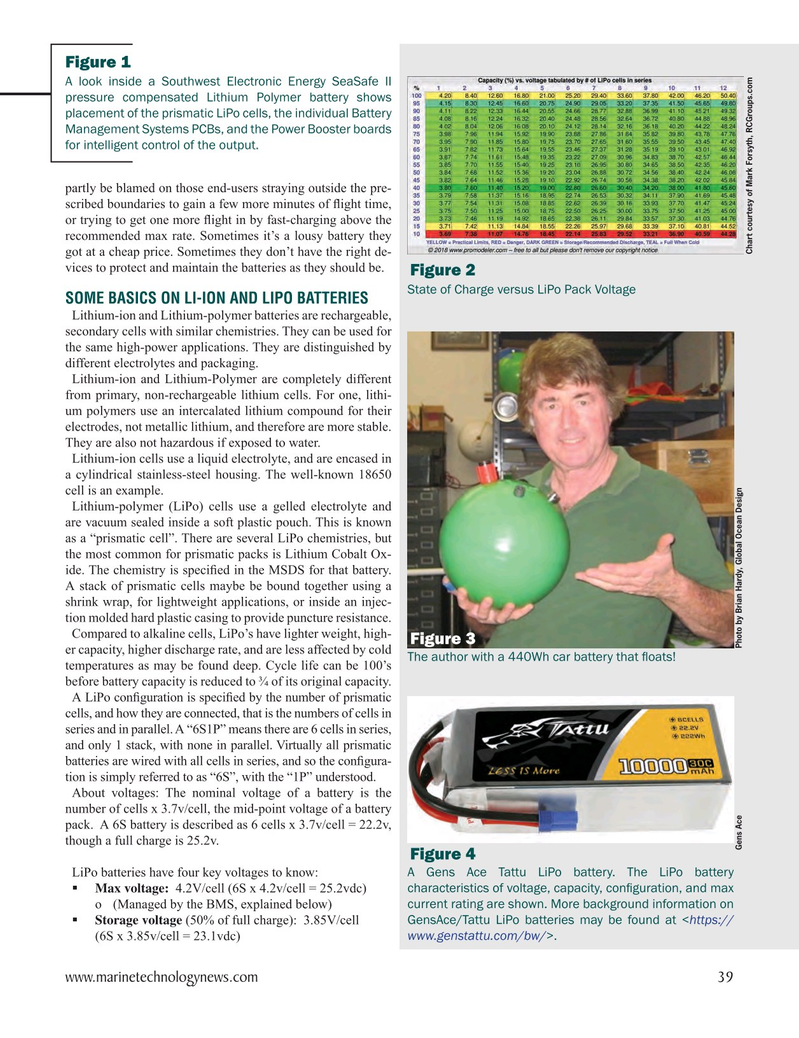
Page 39: of Marine Technology Magazine (November 2022)
Read this page in Pdf, Flash or Html5 edition of November 2022 Marine Technology Magazine
Figure 1
A look inside a Southwest Electronic Energy SeaSafe II pressure compensated Lithium Polymer battery shows placement of the prismatic LiPo cells, the individual Battery
Management Systems PCBs, and the Power Booster boards for intelligent control of the output. partly be blamed on those end-users straying outside the pre- scribed boundaries to gain a few more minutes of ? ight time, or trying to get one more ? ight in by fast-charging above the recommended max rate. Sometimes it’s a lousy battery they
Chart courtesy of Mark Forsyth, RCGroups.com got at a cheap price. Sometimes they don’t have the right de- vices to protect and maintain the batteries as they should be.
Figure 2
State of Charge versus LiPo Pack Voltage
SOME BASICS ON LI-ION AND LIPO BATTERIES
Lithium-ion and Lithium-polymer batteries are rechargeable, secondary cells with similar chemistries. They can be used for the same high-power applications. They are distinguished by different electrolytes and packaging.
Lithium-ion and Lithium-Polymer are completely different from primary, non-rechargeable lithium cells. For one, lithi- um polymers use an intercalated lithium compound for their electrodes, not metallic lithium, and therefore are more stable.
They are also not hazardous if exposed to water.
Lithium-ion cells use a liquid electrolyte, and are encased in a cylindrical stainless-steel housing. The well-known 18650 cell is an example.
Lithium-polymer (LiPo) cells use a gelled electrolyte and are vacuum sealed inside a soft plastic pouch. This is known as a “prismatic cell”. There are several LiPo chemistries, but the most common for prismatic packs is Lithium Cobalt Ox- ide. The chemistry is speci? ed in the MSDS for that battery.
A stack of prismatic cells maybe be bound together using a shrink wrap, for lightweight applications, or inside an injec- tion molded hard plastic casing to provide puncture resistance.
Compared to alkaline cells, LiPo’s have lighter weight, high-
Figure 3 er capacity, higher discharge rate, and are less affected by cold
The author with a 440Wh car battery that ? oats!
temperatures as may be found deep. Cycle life can be 100’s before battery capacity is reduced to ¾ of its original capacity.
A LiPo con? guration is speci? ed by the number of prismatic cells, and how they are connected, that is the numbers of cells in series and in parallel. A “6S1P” means there are 6 cells in series, and only 1 stack, with none in parallel. Virtually all prismatic batteries are wired with all cells in series, and so the con? gura- tion is simply referred to as “6S”, with the “1P” understood.
About voltages: The nominal voltage of a battery is the number of cells x 3.7v/cell, the mid-point voltage of a battery pack. A 6S battery is described as 6 cells x 3.7v/cell = 22.2v, though a full charge is 25.2v.
Gens Ace Photo by Brian Hardy, Global Ocean Design
Figure 4
LiPo batteries have four key voltages to know: A Gens Ace Tattu LiPo battery. The LiPo battery ? Max voltage: 4.2V/cell (6S x 4.2v/cell = 25.2vdc) characteristics of voltage, capacity, con? guration, and max o (Managed by the BMS, explained below) current rating are shown. More background information on ? Storage voltage (50% of full charge): 3.85V/cell GensAce/Tattu LiPo batteries may be found at
MTR #8 (34-49).indd 39 11/28/2022 3:48:35 PM

 38
38

 40
40
